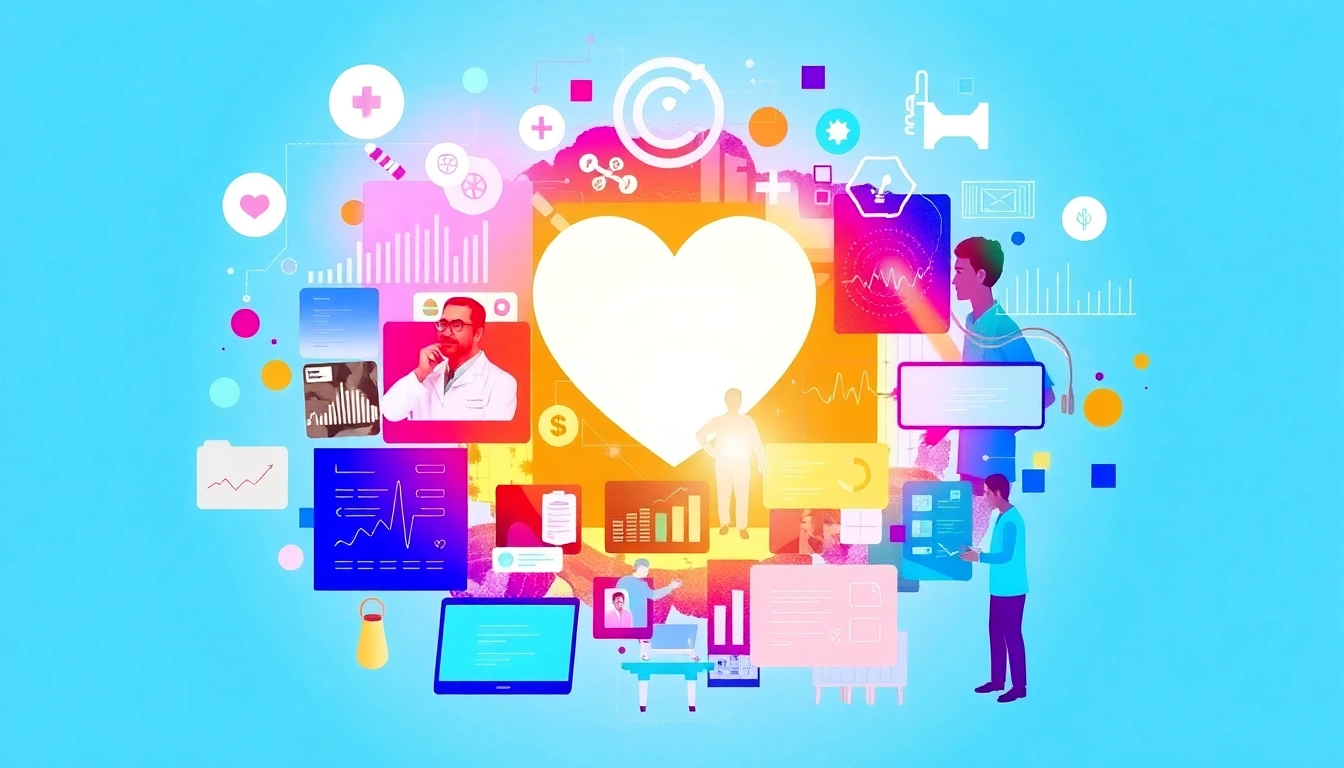Understanding Health Informatics
Health informatics is an interdisciplinary field that merges healthcare with information technology, focusing on the acquisition, storage, analysis, and dissemination of health-related data. The growing adoption of electronic health records (EHRs), clinical decision support systems, and telehealth services has significantly transformed healthcare delivery. This transformation reflects a broader trend towards a data-centric approach in medicine, which is vital for enhancing patient care and healthcare efficiency. For those interested in exploring more about health informatics, including its practical applications and challenges, resources can be accessed at www.informaticsview.com.
Definition and Scope of Health Informatics
The term “health informatics” encompasses the systematic application of information and communication technologies across various healthcare settings. It incorporates disciplines such as computer science, information science, and healthcare science to facilitate better management of health information. Health informatics includes various areas such as:
- Clinical Informatics: Focused on the application of informatics in clinical settings to improve patient care.
- Public Health Informatics: Concentrates on the data exchange and health information system for populations.
- Nursing Informatics: Bridges nursing practices with technology to enhance patient-care documentation and workflows.
- Consumer Health Informatics: Involves the application of health informatics in consumer-facing contexts to improve health literacy and engagement.
Importance of Informatics in Healthcare
The significance of health informatics cannot be overstated, as it revolutionizes the healthcare landscape by enhancing patient safety, improving outcomes, and optimizing workflows. By implementing comprehensive informatics systems, healthcare organizations can achieve:
- Improved Patient Care: Informatics tools can ensure accurate diagnostics and facilitate personalized treatment plans based on patient data analysis.
- Boosted Efficiency: Automation of routine tasks and improved data access reduces the time healthcare professionals spend on administrative duties, allowing them to focus on patient care.
- Data-Driven Decisions: Evidence-based practice is enhanced through effective data management, enabling healthcare providers to make informed decisions that are reflective of the latest research and clinical guidelines.
- Enhanced Communication: Streamlined information sharing across systems improves care coordination among different healthcare professionals.
Trends in Health Informatics
As we look towards the future, several trends are emerging in the field of health informatics that promise to further enhance care delivery:
- Artificial Intelligence (AI): AI is increasingly being integrated into healthcare systems for predictive analytics, patient monitoring, and personalized medicine.
- Wearable Technology: Devices that monitor health metrics in real-time are providing healthcare professionals with continuous data on patient conditions.
- Telemedicine Expansion: Although fast-tracked by the COVID-19 pandemic, telehealth remains a significant trend, offering care continuity for patients with chronic conditions.
- Health Data Interoperability: Improved interoperability standards are being developed to allow different systems to communicate seamlessly, enhancing data exchange across entities.
Key Components and Technologies
Data Management Systems in Healthcare
Central to health informatics is the use of data management systems. These systems help in the electronic storage, retrieval, and analysis of health data. Important aspects include:
- Electronic Health Records (EHRs): EHRs provide a comprehensive view of a patient’s health history and facilitate data sharing among healthcare providers.
- Health Information Exchanges (HIEs): HIEs enable different healthcare entities to exchange patient information efficiently, improving care coordination and reducing duplicate tests.
- Data Warehousing: A system that collates data from different sources provides a central repository for health data, enabling advanced analytics and reporting.
Clinical Decision Support Systems
Clinical Decision Support Systems (CDSS) are essential tools in health informatics. They assist healthcare professionals in making clinical decisions based on the integration of patient data, clinical guidelines, and evidence-based research. Key functions include:
- Alerts and Reminders: CDSS can provide alerts about potential medication interactions or reminders for follow-up tests and screenings.
- Clinical Guidelines: CDSS can present specific patient recommendations derived from established clinical guidelines, reducing variability in care.
- Predictive Analytics: Leveraging data to forecast patient outcomes, helping clinicians to identify high-risk patients early.
Telehealth Technologies
Telehealth technologies have emerged as vital solutions for enhancing access to care and improving patient-provider communication. Major components include:
- Virtual Visits: Secure video conferencing tools allow real-time consultations, overcoming geographical barriers.
- Remote Monitoring: Devices that track patient metrics (like glucose levels or blood pressure) and share them directly with healthcare systems for proactive management.
- Patient Portals: Online platforms that give patients access to their health records, appointment scheduling, and prescription management, promoting engagement in their own care.
Challenges in Implementing Health Informatics
Data Privacy and Security Issues
With the increase in digital health data, protecting patient information has become paramount. Key challenges include:
- Regulatory Compliance: Organizations must comply with regulations such as HIPAA in the United States, which demands high standards of data privacy and security.
- Cybersecurity Threats: Healthcare systems are frequent targets for cyberattacks, necessitating robust security measures, including encryption and regular security audits.
- User Education: Ensuring that healthcare staff are trained in secure data handling practices to reduce risks of breaches through human error is crucial.
Integration with Existing Healthcare Systems
Integrating new informatics solutions with existing healthcare infrastructures can be fraught with challenges. Key issues include:
- Legacy Systems: Many healthcare organizations still operate with outdated technologies that do not easily integrate with modern systems, leading to inefficiencies and data silos.
- Interoperability: Achieving effective data exchange between different systems remains a challenge, often due to lack of standardization in data formats.
- Cost of Implementation: The financial burden of upgrading systems or transitioning to new technologies can be significant and require careful planning and resource allocation.
Workflow Optimization Strategies
To ensure the successful implementation of health informatics solutions, healthcare organizations need to focus on workflow optimization. Key strategies include:
- Process Mapping: Detailed analysis of current workflows to identify areas for improvement and to streamline processes using informatics tools.
- Stakeholder Engagement: Involving all relevant stakeholders in decision-making to align new technologies with the needs and capabilities of healthcare teams.
- Continuous Training: Consistent training programs that empower staff to effectively leverage new technologies to enhance patient care and improve processes.
Practical Applications of Health Informatics
Use Cases in Patient Care
Health informatics presents numerous opportunities for improving patient care through practical applications:
- Personalized Medicine: By analyzing a patient’s unique genetic makeup, healthcare providers can offer tailored treatment plans that are more effective.
- Chronic Disease Management: Continuous data monitoring tools facilitate proactive management of chronic conditions such as diabetes or heart disease, improving treatment adherence.
- Patient Engagement Tools: Applications that support patient education and self-management encourage better health outcomes through informed decision-making.
Improving Patient Outcomes through Analytics
Leveraging analytics within health informatics allows healthcare providers to enhance patient outcomes significantly:
- Predictive Modeling: Analytics can forecast patient deterioration, allowing for timely intervention.
- Benchmarking Best Practices: By analyzing treatment outcomes, organizations can establish best practices and guidelines that improve overall care quality.
- Resource Allocation: Data analysis helps in optimizing resource allocation, ensuring that healthcare providers can meet patient needs efficiently.
Collaboration Tools for Healthcare Teams
Collaboration is critical in healthcare settings, and informatics provides tools that foster teamwork:
- Integrated Communication Platforms: Tools like secure messaging and shared platforms facilitate information sharing among healthcare professionals, leading to coordinated care.
- Remote Collaboration: Telehealth technology allows multidisciplinary teams to collaborate on patient cases regardless of location.
- Documentation Systems: Solutions that allow for seamless documentation and real-time updates enhance team coordination and patient care continuity.
Future of Health Informatics
Emerging Technologies Impacting Healthcare
The evolution of health informatics is continually shaped by technological advancements:
- Blockchain Technology: This emerging technology can enhance data security and integrity in health informatics through decentralized data management.
- Virtual Reality (VR): Emerging as a tool for training and patient engagement, VR can offer simulations that improve understanding and patient experiences.
- Internet of Medical Things (IoMT): A network of connected devices that facilitate continuous monitoring and consultation in healthcare, providing valuable real-time data.
Interdisciplinary Approaches in Informatics
To adapt to changing healthcare needs, interdisciplinary teams are essential in health informatics:
- Healthcare Professionals Collaborating with IT Experts: Joint ventures between clinicians and technologists ensure that informatics solutions are tailored to real-world challenges.
- Involvement of Policy Makers: Collaboration with policymakers can lead to shaping regulations that support the secure and effective use of informatics in healthcare.
- Patient Involvement: Engaging patients in the design and implementation of health informatics tools promotes usability and acceptance.
Preparing for a Career in Health Informatics
For those aspiring to join the health informatics field, there are several pathways and skills to consider:
- Educational Background: Degrees in health informatics, healthcare administration, or computer science can provide a solid foundation.
- Certifications: Obtaining certifications from recognized organizations can enhance credibility and expertise in specialized areas of informatics.
- Networking and Professional Development: Participating in professional organizations, conferences, and workshops can facilitate valuable connections and ongoing learning.



